Report: Analysing Bridgestone's Organisational Strategy (BUS101)
VerifiedAdded on 2020/12/30
|11
|2796
|273
Report
AI Summary
This report presents a detailed analysis of Bridgestone Corporation's organisational strategy. It begins with an introduction to organisational strategy and then delves into the macro-environmental factors affecting Bridgestone, utilizing PESTLE analysis to assess political, economic, social, technological, legal, and environmental influences, particularly within the UK market. The report then examines Bridgestone's industry position using Porter's Five Forces model to evaluate competitive rivalry, supplier power, buyer power, the threat of substitution, and the threat of new entry within the tyre industry. Internal resources and capabilities are assessed using the VRIO framework, focusing on value, rareness, imitability, and organisation. Finally, the report explores the perspectives of various stakeholders, including consumers, government, suppliers, and the board of directors, to understand their impact on the company. The analysis provides a comprehensive overview of Bridgestone's strategic approach, its competitive environment, and its internal strengths and weaknesses, culminating in conclusions regarding its overall strategic effectiveness.
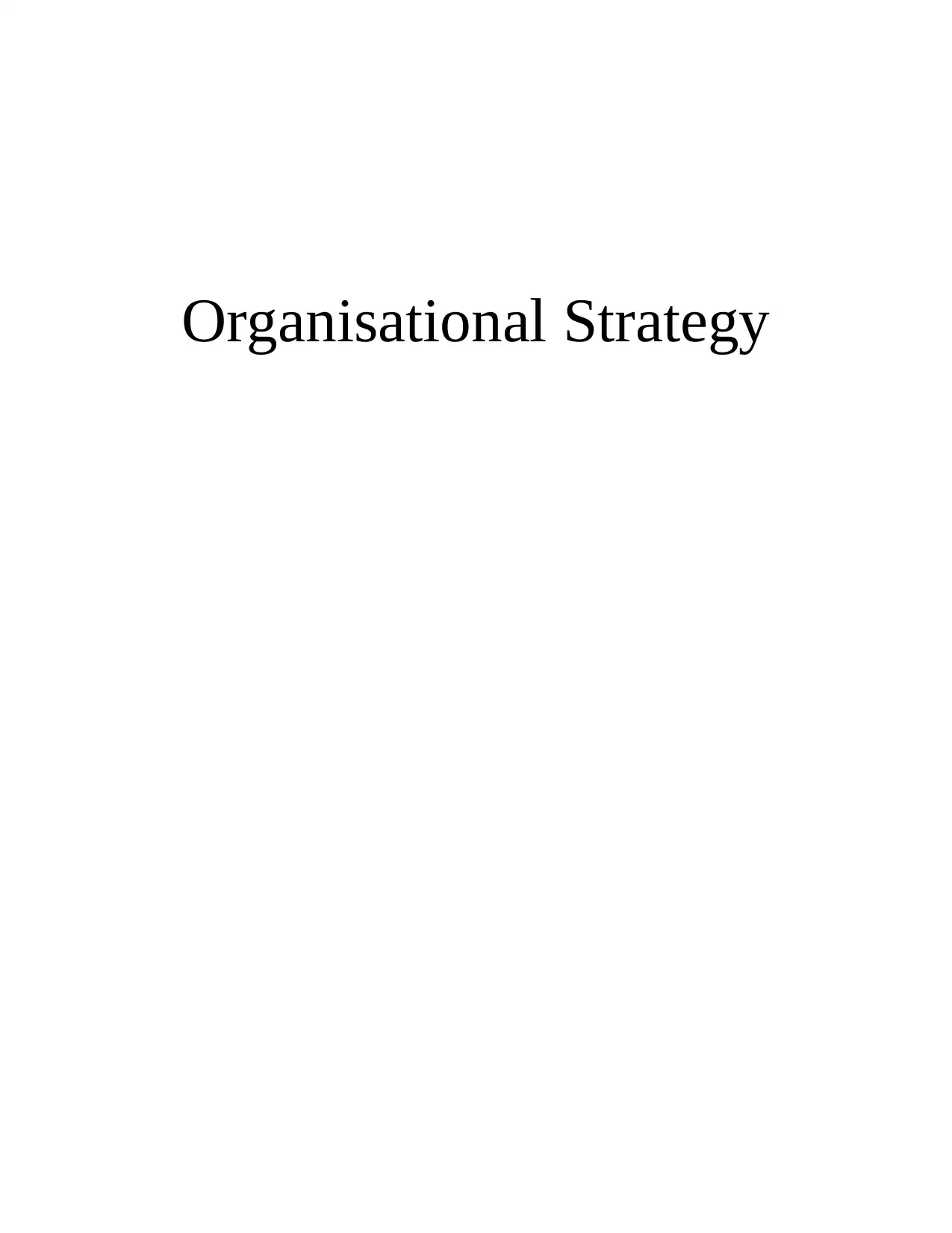
Organisational Strategy
Paraphrase This Document
Need a fresh take? Get an instant paraphrase of this document with our AI Paraphraser
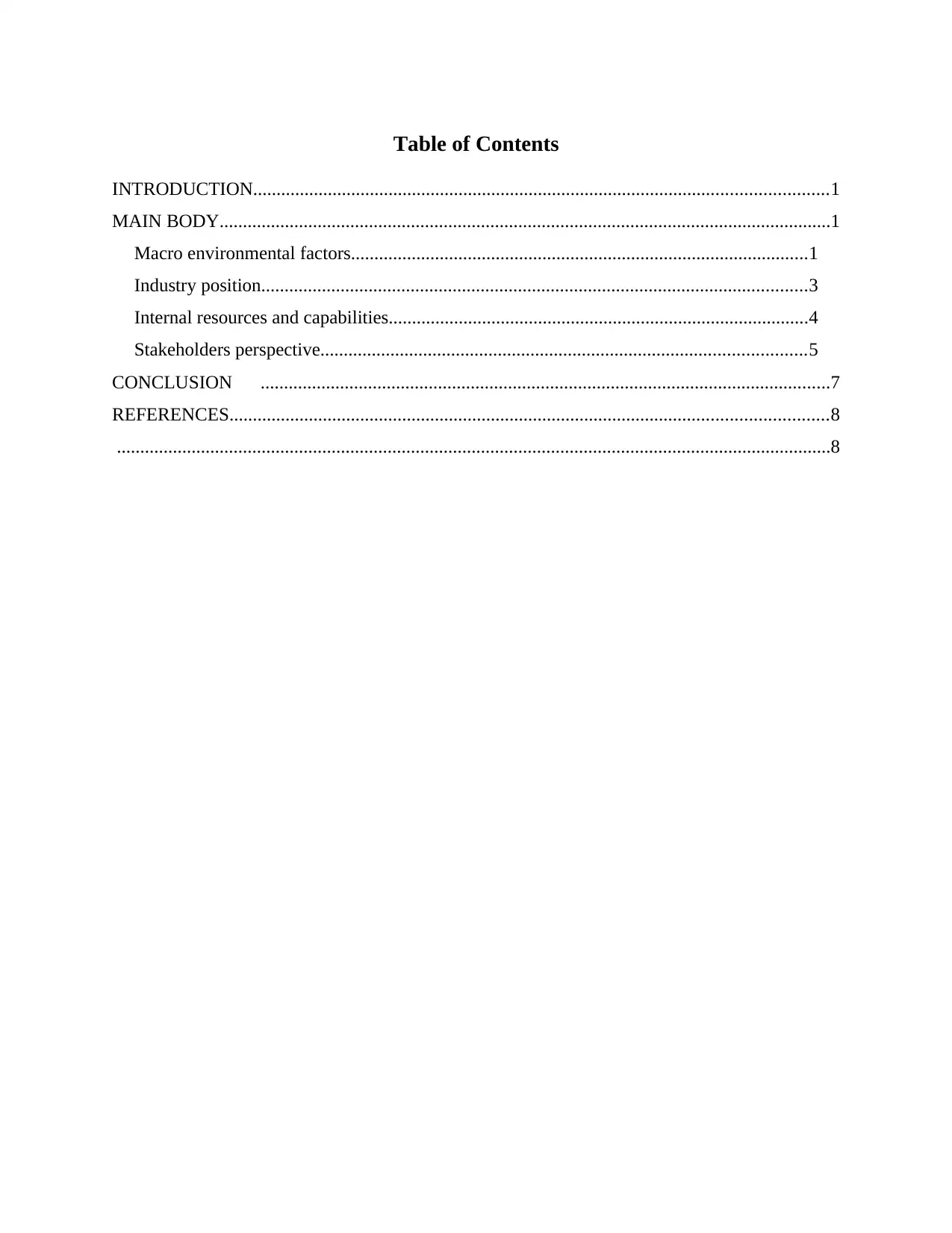
Table of Contents
INTRODUCTION...........................................................................................................................1
MAIN BODY...................................................................................................................................1
Macro environmental factors..................................................................................................1
Industry position.....................................................................................................................3
Internal resources and capabilities..........................................................................................4
Stakeholders perspective........................................................................................................5
CONCLUSION ..........................................................................................................................7
REFERENCES................................................................................................................................8
.........................................................................................................................................................8
INTRODUCTION...........................................................................................................................1
MAIN BODY...................................................................................................................................1
Macro environmental factors..................................................................................................1
Industry position.....................................................................................................................3
Internal resources and capabilities..........................................................................................4
Stakeholders perspective........................................................................................................5
CONCLUSION ..........................................................................................................................7
REFERENCES................................................................................................................................8
.........................................................................................................................................................8

⊘ This is a preview!⊘
Do you want full access?
Subscribe today to unlock all pages.

Trusted by 1+ million students worldwide

INTRODUCTION
Organisational strategy is refers to step by step action taken by a company to attain its pre
set goals and objectives. Focus of the company is equally divide on both types of goals i.e., short
term and long term. In other words, it refers to assessment of working operations of company
that would help them outperform their own performance. For this report, Bridgestone
corporation which is a multinational company is taking for considerations. It deals in auto parts
of different vehicles like car, truck etc.(Ryan and Wilson, 2013). Macro environment will be
elaborated and its impact on Bridgestone's performance will be explained with functional
examples. Beside this how different type of industry factor affects organisation and its
profitability. VRIO approach would be use to find out the internal strengths and weakness and at
last perspective of stakeholders will be elaborated.
MAIN BODY
Macro environmental factors
External environment plays an important role in the success of organisation as it is
linked with the working operations of company. Organisation have to change their strategy and
policies according to the external environment. Company uses PESTLE analysis to scan the
environment which they can not control or modify according to their strengths.
Political factors
This factors determine that what are the factors of government which influence the
operations of bridgestone. It includes tax policy, anti dumping duties or tariffs, environmental
law etc. UK government is strict about the tyres coming from china as it is affecting the prices of
tyres in a negative way (Cserháti and Szabó, 2014). Besides this, UK has good political
connections with Japan as many goods are transferred from both the countries like fashion
apparels, craft accessories etc. It would be easier for company to run their business smoothly in
UK as laws are made in consideration of these companies so that country relation won't get
affected.
Economical factors
It includes all the factors which is directly proportionate to economy of country like
economic growth, currency exchange, inflation rate etc. UK country is ideal for them as they
exchange rate and economic growth is in favour of company. Though exchange rate between
1
Organisational strategy is refers to step by step action taken by a company to attain its pre
set goals and objectives. Focus of the company is equally divide on both types of goals i.e., short
term and long term. In other words, it refers to assessment of working operations of company
that would help them outperform their own performance. For this report, Bridgestone
corporation which is a multinational company is taking for considerations. It deals in auto parts
of different vehicles like car, truck etc.(Ryan and Wilson, 2013). Macro environment will be
elaborated and its impact on Bridgestone's performance will be explained with functional
examples. Beside this how different type of industry factor affects organisation and its
profitability. VRIO approach would be use to find out the internal strengths and weakness and at
last perspective of stakeholders will be elaborated.
MAIN BODY
Macro environmental factors
External environment plays an important role in the success of organisation as it is
linked with the working operations of company. Organisation have to change their strategy and
policies according to the external environment. Company uses PESTLE analysis to scan the
environment which they can not control or modify according to their strengths.
Political factors
This factors determine that what are the factors of government which influence the
operations of bridgestone. It includes tax policy, anti dumping duties or tariffs, environmental
law etc. UK government is strict about the tyres coming from china as it is affecting the prices of
tyres in a negative way (Cserháti and Szabó, 2014). Besides this, UK has good political
connections with Japan as many goods are transferred from both the countries like fashion
apparels, craft accessories etc. It would be easier for company to run their business smoothly in
UK as laws are made in consideration of these companies so that country relation won't get
affected.
Economical factors
It includes all the factors which is directly proportionate to economy of country like
economic growth, currency exchange, inflation rate etc. UK country is ideal for them as they
exchange rate and economic growth is in favour of company. Though exchange rate between
1
Paraphrase This Document
Need a fresh take? Get an instant paraphrase of this document with our AI Paraphraser
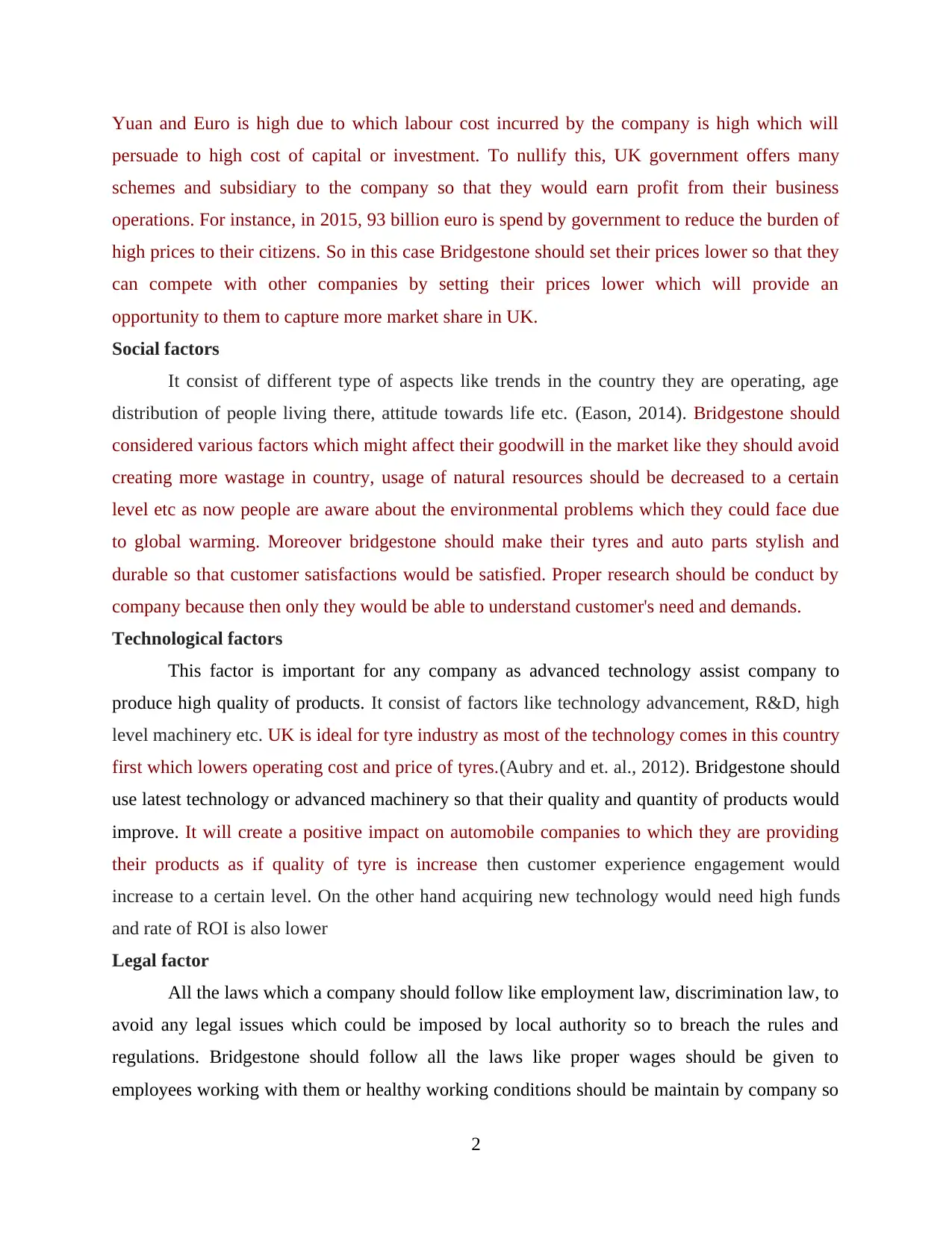
Yuan and Euro is high due to which labour cost incurred by the company is high which will
persuade to high cost of capital or investment. To nullify this, UK government offers many
schemes and subsidiary to the company so that they would earn profit from their business
operations. For instance, in 2015, 93 billion euro is spend by government to reduce the burden of
high prices to their citizens. So in this case Bridgestone should set their prices lower so that they
can compete with other companies by setting their prices lower which will provide an
opportunity to them to capture more market share in UK.
Social factors
It consist of different type of aspects like trends in the country they are operating, age
distribution of people living there, attitude towards life etc. (Eason, 2014). Bridgestone should
considered various factors which might affect their goodwill in the market like they should avoid
creating more wastage in country, usage of natural resources should be decreased to a certain
level etc as now people are aware about the environmental problems which they could face due
to global warming. Moreover bridgestone should make their tyres and auto parts stylish and
durable so that customer satisfactions would be satisfied. Proper research should be conduct by
company because then only they would be able to understand customer's need and demands.
Technological factors
This factor is important for any company as advanced technology assist company to
produce high quality of products. It consist of factors like technology advancement, R&D, high
level machinery etc. UK is ideal for tyre industry as most of the technology comes in this country
first which lowers operating cost and price of tyres.(Aubry and et. al., 2012). Bridgestone should
use latest technology or advanced machinery so that their quality and quantity of products would
improve. It will create a positive impact on automobile companies to which they are providing
their products as if quality of tyre is increase then customer experience engagement would
increase to a certain level. On the other hand acquiring new technology would need high funds
and rate of ROI is also lower
Legal factor
All the laws which a company should follow like employment law, discrimination law, to
avoid any legal issues which could be imposed by local authority so to breach the rules and
regulations. Bridgestone should follow all the laws like proper wages should be given to
employees working with them or healthy working conditions should be maintain by company so
2
persuade to high cost of capital or investment. To nullify this, UK government offers many
schemes and subsidiary to the company so that they would earn profit from their business
operations. For instance, in 2015, 93 billion euro is spend by government to reduce the burden of
high prices to their citizens. So in this case Bridgestone should set their prices lower so that they
can compete with other companies by setting their prices lower which will provide an
opportunity to them to capture more market share in UK.
Social factors
It consist of different type of aspects like trends in the country they are operating, age
distribution of people living there, attitude towards life etc. (Eason, 2014). Bridgestone should
considered various factors which might affect their goodwill in the market like they should avoid
creating more wastage in country, usage of natural resources should be decreased to a certain
level etc as now people are aware about the environmental problems which they could face due
to global warming. Moreover bridgestone should make their tyres and auto parts stylish and
durable so that customer satisfactions would be satisfied. Proper research should be conduct by
company because then only they would be able to understand customer's need and demands.
Technological factors
This factor is important for any company as advanced technology assist company to
produce high quality of products. It consist of factors like technology advancement, R&D, high
level machinery etc. UK is ideal for tyre industry as most of the technology comes in this country
first which lowers operating cost and price of tyres.(Aubry and et. al., 2012). Bridgestone should
use latest technology or advanced machinery so that their quality and quantity of products would
improve. It will create a positive impact on automobile companies to which they are providing
their products as if quality of tyre is increase then customer experience engagement would
increase to a certain level. On the other hand acquiring new technology would need high funds
and rate of ROI is also lower
Legal factor
All the laws which a company should follow like employment law, discrimination law, to
avoid any legal issues which could be imposed by local authority so to breach the rules and
regulations. Bridgestone should follow all the laws like proper wages should be given to
employees working with them or healthy working conditions should be maintain by company so
2
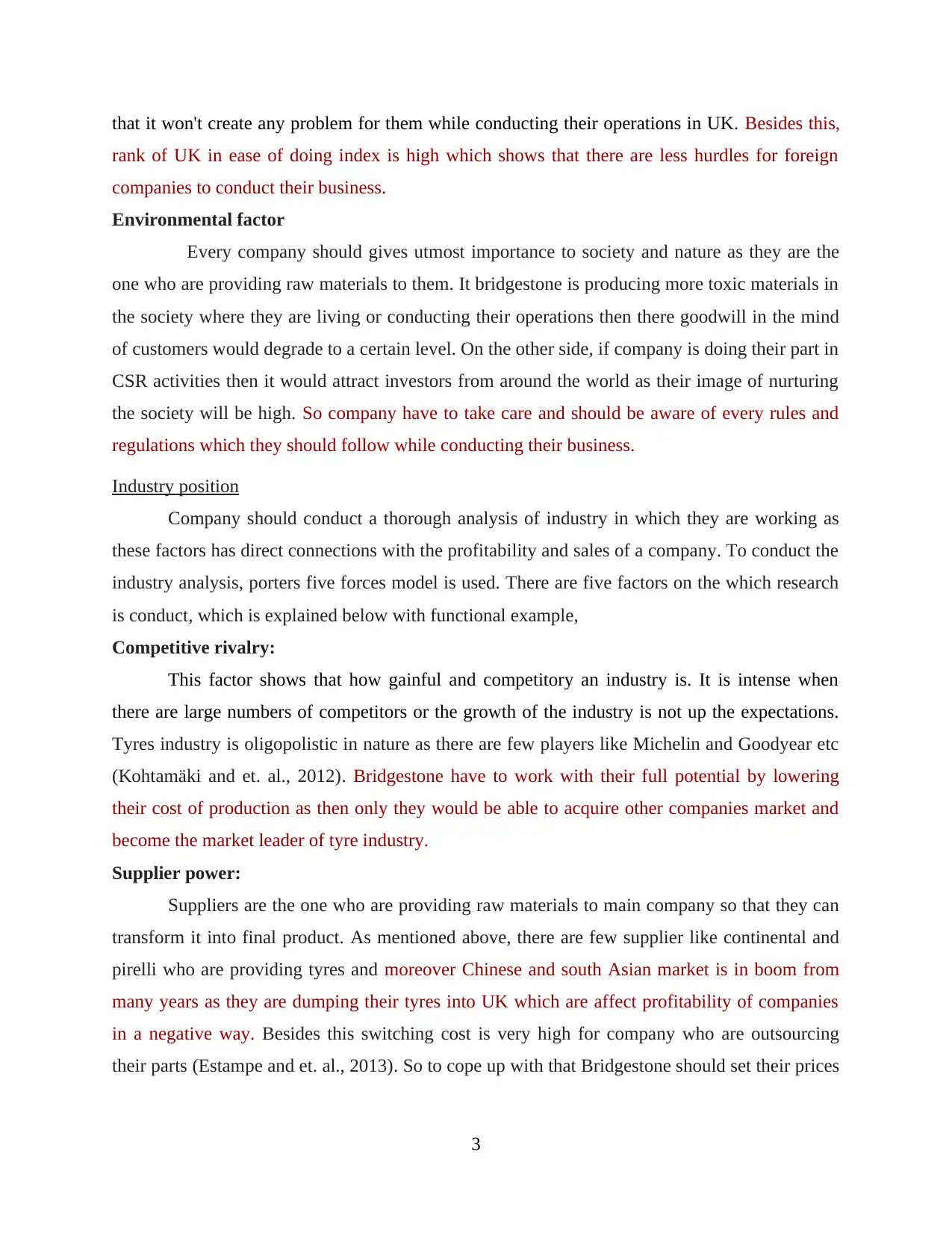
that it won't create any problem for them while conducting their operations in UK. Besides this,
rank of UK in ease of doing index is high which shows that there are less hurdles for foreign
companies to conduct their business.
Environmental factor
Every company should gives utmost importance to society and nature as they are the
one who are providing raw materials to them. It bridgestone is producing more toxic materials in
the society where they are living or conducting their operations then there goodwill in the mind
of customers would degrade to a certain level. On the other side, if company is doing their part in
CSR activities then it would attract investors from around the world as their image of nurturing
the society will be high. So company have to take care and should be aware of every rules and
regulations which they should follow while conducting their business.
Industry position
Company should conduct a thorough analysis of industry in which they are working as
these factors has direct connections with the profitability and sales of a company. To conduct the
industry analysis, porters five forces model is used. There are five factors on the which research
is conduct, which is explained below with functional example,
Competitive rivalry:
This factor shows that how gainful and competitory an industry is. It is intense when
there are large numbers of competitors or the growth of the industry is not up the expectations.
Tyres industry is oligopolistic in nature as there are few players like Michelin and Goodyear etc
(Kohtamäki and et. al., 2012). Bridgestone have to work with their full potential by lowering
their cost of production as then only they would be able to acquire other companies market and
become the market leader of tyre industry.
Supplier power:
Suppliers are the one who are providing raw materials to main company so that they can
transform it into final product. As mentioned above, there are few supplier like continental and
pirelli who are providing tyres and moreover Chinese and south Asian market is in boom from
many years as they are dumping their tyres into UK which are affect profitability of companies
in a negative way. Besides this switching cost is very high for company who are outsourcing
their parts (Estampe and et. al., 2013). So to cope up with that Bridgestone should set their prices
3
rank of UK in ease of doing index is high which shows that there are less hurdles for foreign
companies to conduct their business.
Environmental factor
Every company should gives utmost importance to society and nature as they are the
one who are providing raw materials to them. It bridgestone is producing more toxic materials in
the society where they are living or conducting their operations then there goodwill in the mind
of customers would degrade to a certain level. On the other side, if company is doing their part in
CSR activities then it would attract investors from around the world as their image of nurturing
the society will be high. So company have to take care and should be aware of every rules and
regulations which they should follow while conducting their business.
Industry position
Company should conduct a thorough analysis of industry in which they are working as
these factors has direct connections with the profitability and sales of a company. To conduct the
industry analysis, porters five forces model is used. There are five factors on the which research
is conduct, which is explained below with functional example,
Competitive rivalry:
This factor shows that how gainful and competitory an industry is. It is intense when
there are large numbers of competitors or the growth of the industry is not up the expectations.
Tyres industry is oligopolistic in nature as there are few players like Michelin and Goodyear etc
(Kohtamäki and et. al., 2012). Bridgestone have to work with their full potential by lowering
their cost of production as then only they would be able to acquire other companies market and
become the market leader of tyre industry.
Supplier power:
Suppliers are the one who are providing raw materials to main company so that they can
transform it into final product. As mentioned above, there are few supplier like continental and
pirelli who are providing tyres and moreover Chinese and south Asian market is in boom from
many years as they are dumping their tyres into UK which are affect profitability of companies
in a negative way. Besides this switching cost is very high for company who are outsourcing
their parts (Estampe and et. al., 2013). So to cope up with that Bridgestone should set their prices
3
⊘ This is a preview!⊘
Do you want full access?
Subscribe today to unlock all pages.

Trusted by 1+ million students worldwide
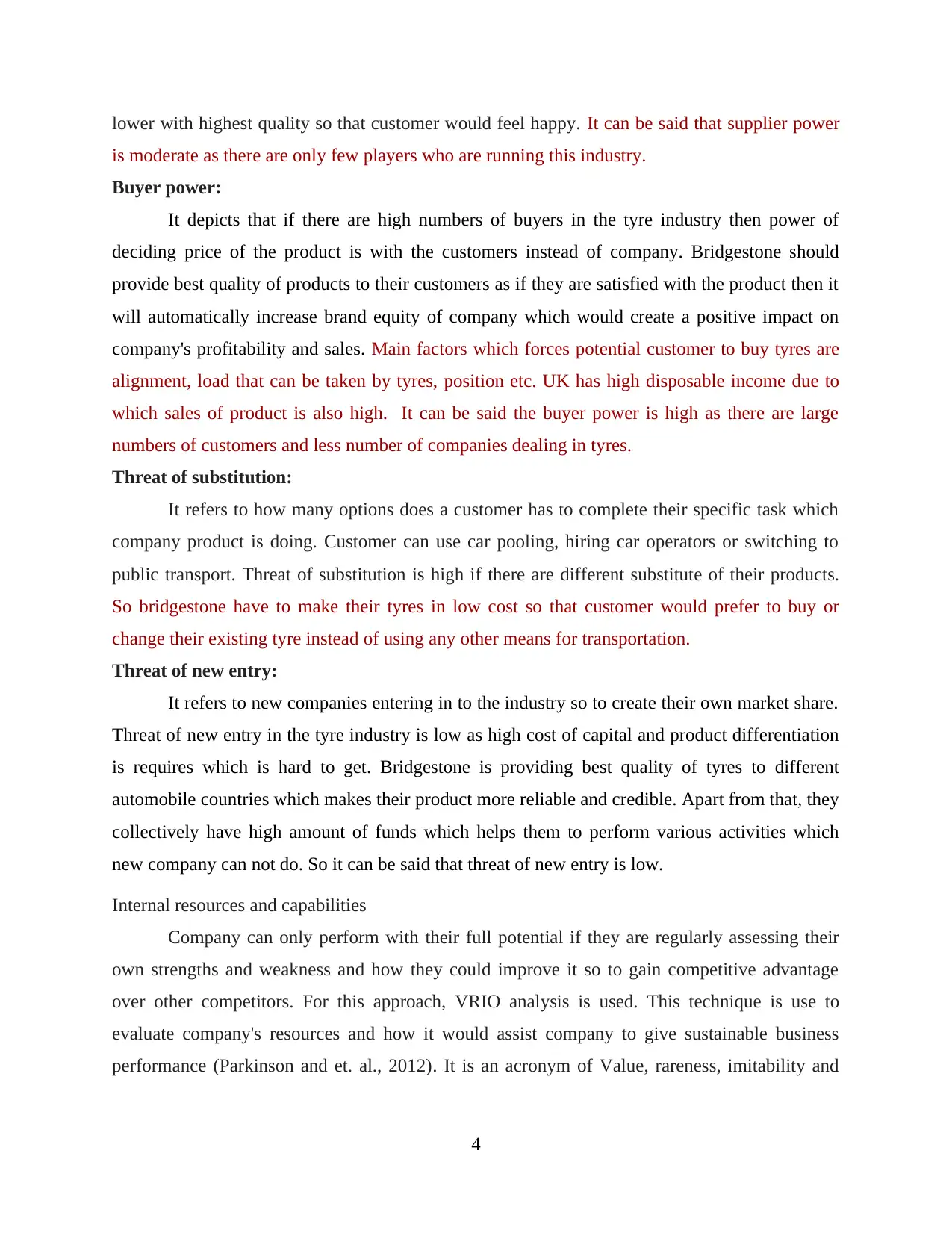
lower with highest quality so that customer would feel happy. It can be said that supplier power
is moderate as there are only few players who are running this industry.
Buyer power:
It depicts that if there are high numbers of buyers in the tyre industry then power of
deciding price of the product is with the customers instead of company. Bridgestone should
provide best quality of products to their customers as if they are satisfied with the product then it
will automatically increase brand equity of company which would create a positive impact on
company's profitability and sales. Main factors which forces potential customer to buy tyres are
alignment, load that can be taken by tyres, position etc. UK has high disposable income due to
which sales of product is also high. It can be said the buyer power is high as there are large
numbers of customers and less number of companies dealing in tyres.
Threat of substitution:
It refers to how many options does a customer has to complete their specific task which
company product is doing. Customer can use car pooling, hiring car operators or switching to
public transport. Threat of substitution is high if there are different substitute of their products.
So bridgestone have to make their tyres in low cost so that customer would prefer to buy or
change their existing tyre instead of using any other means for transportation.
Threat of new entry:
It refers to new companies entering in to the industry so to create their own market share.
Threat of new entry in the tyre industry is low as high cost of capital and product differentiation
is requires which is hard to get. Bridgestone is providing best quality of tyres to different
automobile countries which makes their product more reliable and credible. Apart from that, they
collectively have high amount of funds which helps them to perform various activities which
new company can not do. So it can be said that threat of new entry is low.
Internal resources and capabilities
Company can only perform with their full potential if they are regularly assessing their
own strengths and weakness and how they could improve it so to gain competitive advantage
over other competitors. For this approach, VRIO analysis is used. This technique is use to
evaluate company's resources and how it would assist company to give sustainable business
performance (Parkinson and et. al., 2012). It is an acronym of Value, rareness, imitability and
4
is moderate as there are only few players who are running this industry.
Buyer power:
It depicts that if there are high numbers of buyers in the tyre industry then power of
deciding price of the product is with the customers instead of company. Bridgestone should
provide best quality of products to their customers as if they are satisfied with the product then it
will automatically increase brand equity of company which would create a positive impact on
company's profitability and sales. Main factors which forces potential customer to buy tyres are
alignment, load that can be taken by tyres, position etc. UK has high disposable income due to
which sales of product is also high. It can be said the buyer power is high as there are large
numbers of customers and less number of companies dealing in tyres.
Threat of substitution:
It refers to how many options does a customer has to complete their specific task which
company product is doing. Customer can use car pooling, hiring car operators or switching to
public transport. Threat of substitution is high if there are different substitute of their products.
So bridgestone have to make their tyres in low cost so that customer would prefer to buy or
change their existing tyre instead of using any other means for transportation.
Threat of new entry:
It refers to new companies entering in to the industry so to create their own market share.
Threat of new entry in the tyre industry is low as high cost of capital and product differentiation
is requires which is hard to get. Bridgestone is providing best quality of tyres to different
automobile countries which makes their product more reliable and credible. Apart from that, they
collectively have high amount of funds which helps them to perform various activities which
new company can not do. So it can be said that threat of new entry is low.
Internal resources and capabilities
Company can only perform with their full potential if they are regularly assessing their
own strengths and weakness and how they could improve it so to gain competitive advantage
over other competitors. For this approach, VRIO analysis is used. This technique is use to
evaluate company's resources and how it would assist company to give sustainable business
performance (Parkinson and et. al., 2012). It is an acronym of Value, rareness, imitability and
4
Paraphrase This Document
Need a fresh take? Get an instant paraphrase of this document with our AI Paraphraser
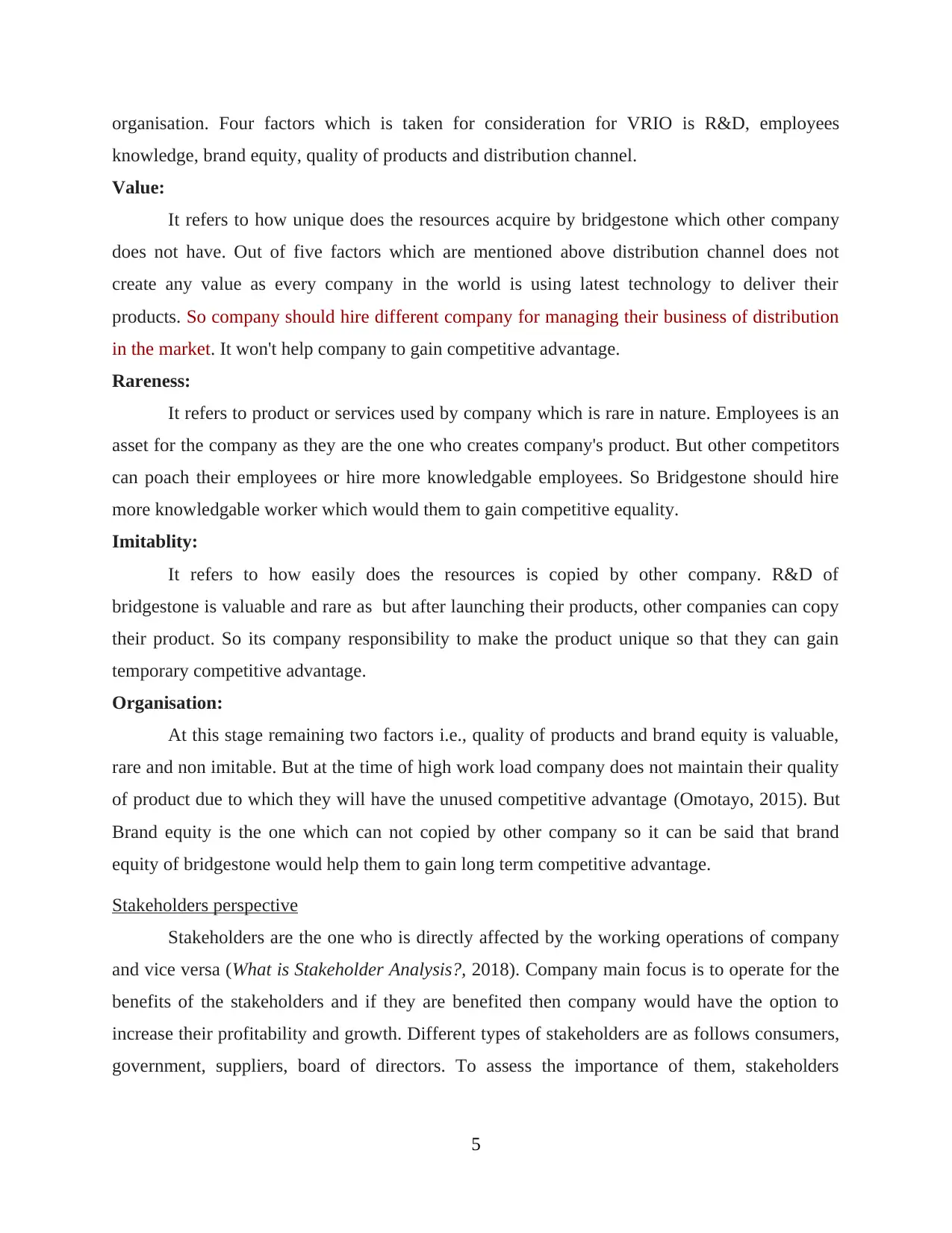
organisation. Four factors which is taken for consideration for VRIO is R&D, employees
knowledge, brand equity, quality of products and distribution channel.
Value:
It refers to how unique does the resources acquire by bridgestone which other company
does not have. Out of five factors which are mentioned above distribution channel does not
create any value as every company in the world is using latest technology to deliver their
products. So company should hire different company for managing their business of distribution
in the market. It won't help company to gain competitive advantage.
Rareness:
It refers to product or services used by company which is rare in nature. Employees is an
asset for the company as they are the one who creates company's product. But other competitors
can poach their employees or hire more knowledgable employees. So Bridgestone should hire
more knowledgable worker which would them to gain competitive equality.
Imitablity:
It refers to how easily does the resources is copied by other company. R&D of
bridgestone is valuable and rare as but after launching their products, other companies can copy
their product. So its company responsibility to make the product unique so that they can gain
temporary competitive advantage.
Organisation:
At this stage remaining two factors i.e., quality of products and brand equity is valuable,
rare and non imitable. But at the time of high work load company does not maintain their quality
of product due to which they will have the unused competitive advantage (Omotayo, 2015). But
Brand equity is the one which can not copied by other company so it can be said that brand
equity of bridgestone would help them to gain long term competitive advantage.
Stakeholders perspective
Stakeholders are the one who is directly affected by the working operations of company
and vice versa (What is Stakeholder Analysis?, 2018). Company main focus is to operate for the
benefits of the stakeholders and if they are benefited then company would have the option to
increase their profitability and growth. Different types of stakeholders are as follows consumers,
government, suppliers, board of directors. To assess the importance of them, stakeholders
5
knowledge, brand equity, quality of products and distribution channel.
Value:
It refers to how unique does the resources acquire by bridgestone which other company
does not have. Out of five factors which are mentioned above distribution channel does not
create any value as every company in the world is using latest technology to deliver their
products. So company should hire different company for managing their business of distribution
in the market. It won't help company to gain competitive advantage.
Rareness:
It refers to product or services used by company which is rare in nature. Employees is an
asset for the company as they are the one who creates company's product. But other competitors
can poach their employees or hire more knowledgable employees. So Bridgestone should hire
more knowledgable worker which would them to gain competitive equality.
Imitablity:
It refers to how easily does the resources is copied by other company. R&D of
bridgestone is valuable and rare as but after launching their products, other companies can copy
their product. So its company responsibility to make the product unique so that they can gain
temporary competitive advantage.
Organisation:
At this stage remaining two factors i.e., quality of products and brand equity is valuable,
rare and non imitable. But at the time of high work load company does not maintain their quality
of product due to which they will have the unused competitive advantage (Omotayo, 2015). But
Brand equity is the one which can not copied by other company so it can be said that brand
equity of bridgestone would help them to gain long term competitive advantage.
Stakeholders perspective
Stakeholders are the one who is directly affected by the working operations of company
and vice versa (What is Stakeholder Analysis?, 2018). Company main focus is to operate for the
benefits of the stakeholders and if they are benefited then company would have the option to
increase their profitability and growth. Different types of stakeholders are as follows consumers,
government, suppliers, board of directors. To assess the importance of them, stakeholders
5
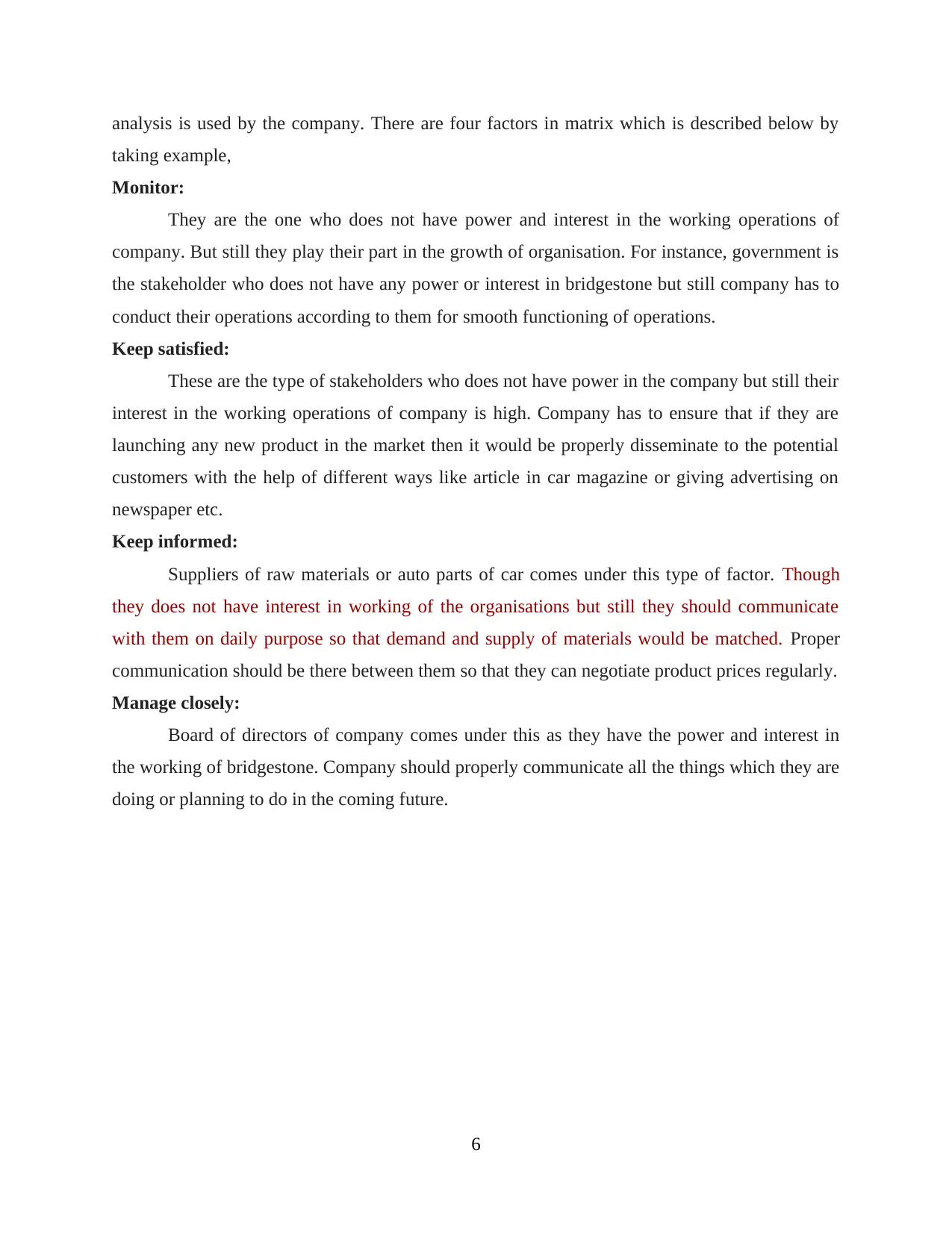
analysis is used by the company. There are four factors in matrix which is described below by
taking example,
Monitor:
They are the one who does not have power and interest in the working operations of
company. But still they play their part in the growth of organisation. For instance, government is
the stakeholder who does not have any power or interest in bridgestone but still company has to
conduct their operations according to them for smooth functioning of operations.
Keep satisfied:
These are the type of stakeholders who does not have power in the company but still their
interest in the working operations of company is high. Company has to ensure that if they are
launching any new product in the market then it would be properly disseminate to the potential
customers with the help of different ways like article in car magazine or giving advertising on
newspaper etc.
Keep informed:
Suppliers of raw materials or auto parts of car comes under this type of factor. Though
they does not have interest in working of the organisations but still they should communicate
with them on daily purpose so that demand and supply of materials would be matched. Proper
communication should be there between them so that they can negotiate product prices regularly.
Manage closely:
Board of directors of company comes under this as they have the power and interest in
the working of bridgestone. Company should properly communicate all the things which they are
doing or planning to do in the coming future.
6
taking example,
Monitor:
They are the one who does not have power and interest in the working operations of
company. But still they play their part in the growth of organisation. For instance, government is
the stakeholder who does not have any power or interest in bridgestone but still company has to
conduct their operations according to them for smooth functioning of operations.
Keep satisfied:
These are the type of stakeholders who does not have power in the company but still their
interest in the working operations of company is high. Company has to ensure that if they are
launching any new product in the market then it would be properly disseminate to the potential
customers with the help of different ways like article in car magazine or giving advertising on
newspaper etc.
Keep informed:
Suppliers of raw materials or auto parts of car comes under this type of factor. Though
they does not have interest in working of the organisations but still they should communicate
with them on daily purpose so that demand and supply of materials would be matched. Proper
communication should be there between them so that they can negotiate product prices regularly.
Manage closely:
Board of directors of company comes under this as they have the power and interest in
the working of bridgestone. Company should properly communicate all the things which they are
doing or planning to do in the coming future.
6
⊘ This is a preview!⊘
Do you want full access?
Subscribe today to unlock all pages.

Trusted by 1+ million students worldwide
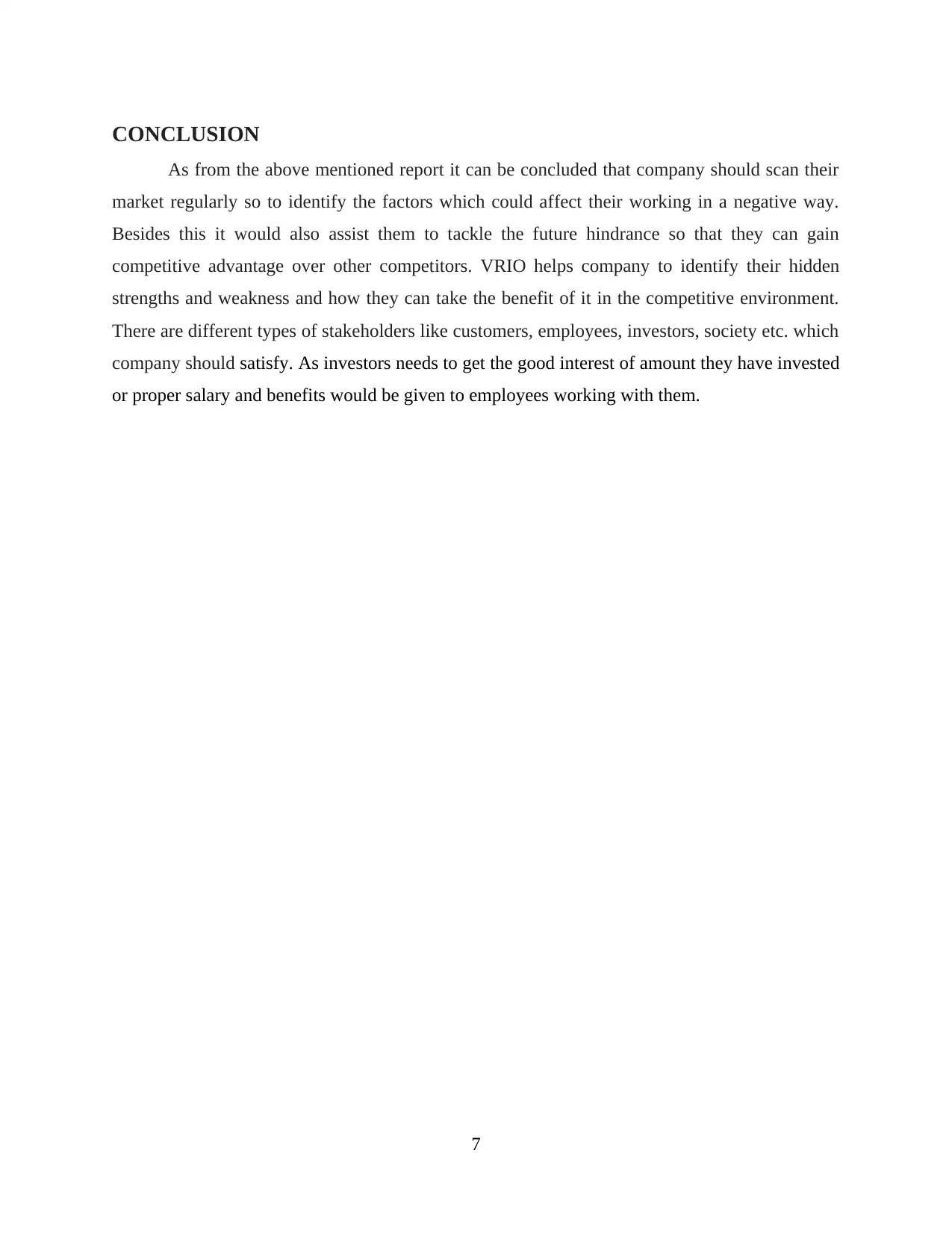
CONCLUSION
As from the above mentioned report it can be concluded that company should scan their
market regularly so to identify the factors which could affect their working in a negative way.
Besides this it would also assist them to tackle the future hindrance so that they can gain
competitive advantage over other competitors. VRIO helps company to identify their hidden
strengths and weakness and how they can take the benefit of it in the competitive environment.
There are different types of stakeholders like customers, employees, investors, society etc. which
company should satisfy. As investors needs to get the good interest of amount they have invested
or proper salary and benefits would be given to employees working with them.
7
As from the above mentioned report it can be concluded that company should scan their
market regularly so to identify the factors which could affect their working in a negative way.
Besides this it would also assist them to tackle the future hindrance so that they can gain
competitive advantage over other competitors. VRIO helps company to identify their hidden
strengths and weakness and how they can take the benefit of it in the competitive environment.
There are different types of stakeholders like customers, employees, investors, society etc. which
company should satisfy. As investors needs to get the good interest of amount they have invested
or proper salary and benefits would be given to employees working with them.
7
Paraphrase This Document
Need a fresh take? Get an instant paraphrase of this document with our AI Paraphraser
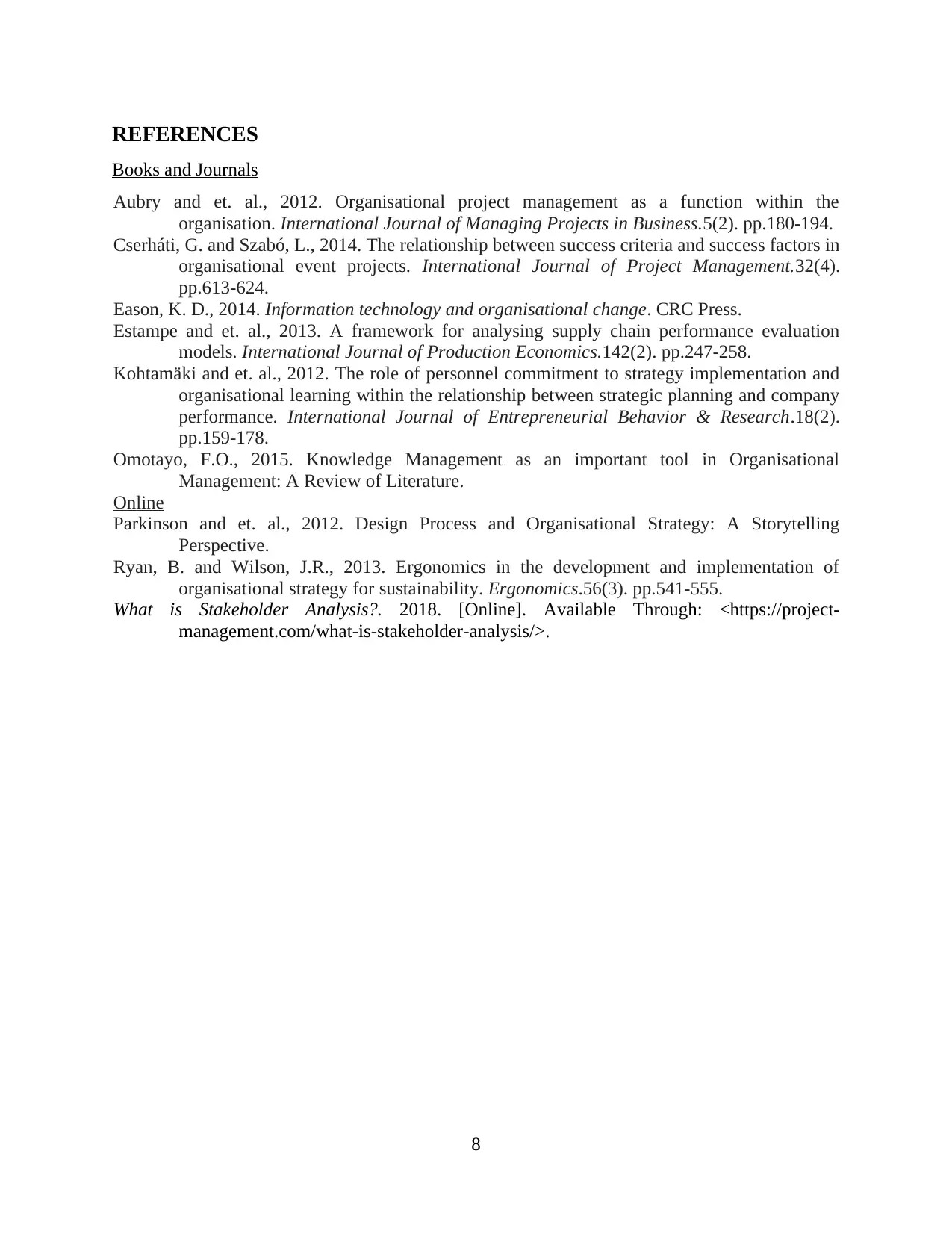
REFERENCES
Books and Journals
Aubry and et. al., 2012. Organisational project management as a function within the
organisation. International Journal of Managing Projects in Business.5(2). pp.180-194.
Cserháti, G. and Szabó, L., 2014. The relationship between success criteria and success factors in
organisational event projects. International Journal of Project Management.32(4).
pp.613-624.
Eason, K. D., 2014. Information technology and organisational change. CRC Press.
Estampe and et. al., 2013. A framework for analysing supply chain performance evaluation
models. International Journal of Production Economics.142(2). pp.247-258.
Kohtamäki and et. al., 2012. The role of personnel commitment to strategy implementation and
organisational learning within the relationship between strategic planning and company
performance. International Journal of Entrepreneurial Behavior & Research.18(2).
pp.159-178.
Omotayo, F.O., 2015. Knowledge Management as an important tool in Organisational
Management: A Review of Literature.
Online
Parkinson and et. al., 2012. Design Process and Organisational Strategy: A Storytelling
Perspective.
Ryan, B. and Wilson, J.R., 2013. Ergonomics in the development and implementation of
organisational strategy for sustainability. Ergonomics.56(3). pp.541-555.
What is Stakeholder Analysis?. 2018. [Online]. Available Through: <https://project-
management.com/what-is-stakeholder-analysis/>.
8
Books and Journals
Aubry and et. al., 2012. Organisational project management as a function within the
organisation. International Journal of Managing Projects in Business.5(2). pp.180-194.
Cserháti, G. and Szabó, L., 2014. The relationship between success criteria and success factors in
organisational event projects. International Journal of Project Management.32(4).
pp.613-624.
Eason, K. D., 2014. Information technology and organisational change. CRC Press.
Estampe and et. al., 2013. A framework for analysing supply chain performance evaluation
models. International Journal of Production Economics.142(2). pp.247-258.
Kohtamäki and et. al., 2012. The role of personnel commitment to strategy implementation and
organisational learning within the relationship between strategic planning and company
performance. International Journal of Entrepreneurial Behavior & Research.18(2).
pp.159-178.
Omotayo, F.O., 2015. Knowledge Management as an important tool in Organisational
Management: A Review of Literature.
Online
Parkinson and et. al., 2012. Design Process and Organisational Strategy: A Storytelling
Perspective.
Ryan, B. and Wilson, J.R., 2013. Ergonomics in the development and implementation of
organisational strategy for sustainability. Ergonomics.56(3). pp.541-555.
What is Stakeholder Analysis?. 2018. [Online]. Available Through: <https://project-
management.com/what-is-stakeholder-analysis/>.
8
1 out of 11
Related Documents
Your All-in-One AI-Powered Toolkit for Academic Success.
+13062052269
info@desklib.com
Available 24*7 on WhatsApp / Email
![[object Object]](/_next/static/media/star-bottom.7253800d.svg)
Unlock your academic potential
Copyright © 2020–2025 A2Z Services. All Rights Reserved. Developed and managed by ZUCOL.





